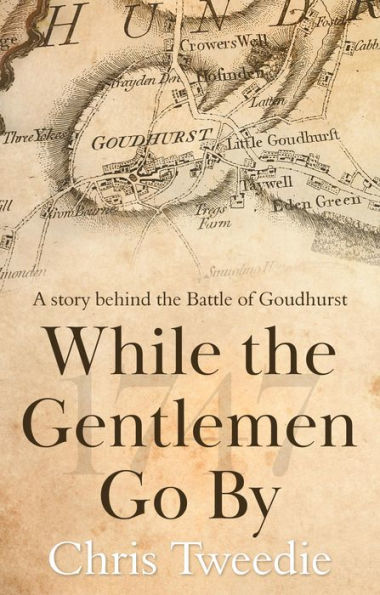Goudhurst is a picturesque village in the southeast English county of Kent. A battle was fought there when the villagers stood up to an organised crime gang of its day – land smugglers.
The early 18th century saw a massive increase in the scale of smuggling. Until then, dealing in contraband was largely exporting wool – England’s most valuable commodity. It changed to a barter system where the wool was traded for highly taxed tea, coveted silks and lace and illegal French brandy - reaping vast profits and robbing the Government’s exchequer.
The trade was loved by many because it provided regular high earnings for struggling labourers and their families, and cheap (i.e. untaxed) luxuries for the middle classes. Local assistance came in various forms: providing information, giving warnings, lending animals to transport goods, hiding goods on properties – even harassing Customs’ officers.
But it was hated by many others. Traders who paid taxes were undercut. Loyalists were outraged by the smugglers’ support for the Jacobite cause and trading with the French whilst at war. Farmers could not find labourers to employ.
Smuggling gangs had brutal reputations – and none more so than the Hawkhurst Gang. To them, violence was a necessary tool to ensure business success. They were unafraid to use rioting and intimidation against anyone who obstructed their path, Customs officers and soldiers included.
It was made worse by the Government's progressive crackdowns - culminating in1745 when smuggling was made an offence that could proclaim a named person an outlaw and which carried the death penalty. The smugglers were on constant lookout to deter informers.
By 1747 the Hawkhurst Gang, had become so wanton that honest folk were abandoning their houses and moving their families away.
It was into this cauldron that William Sturt returned to his birthplace of Goudhurst. He had been honourably discharged from the army as a corporal and become so disturbed by the smugglers’ oppression he formed a militia.
Of course, the smugglers heard about the opposition and laid down a challenge: They would murder the inhabitants and burn the village to the ground. The villagers had fewer than 30 hours to set their defences before the smugglers said they would bear down on them.
Much of the truth about the Battle of Goudhurst has been embellished or muddied over the years of retelling. How many men were on each side? Where was the battle fought? How did the militia arm themselves?
Retired journalist Chris Tweedie has for more than four years sifted through the numerous accounts of the battle. While a work of historical fiction he has uncovered some surprising information.
While the Gentlemen Go By takes its name from a familiar line from Rudyard Kipling’s loved poem “Smugglers Song”.
Goudhurst is a picturesque village in the southeast English county of Kent. A battle was fought there when the villagers stood up to an organised crime gang of its day – land smugglers.
The early 18th century saw a massive increase in the scale of smuggling. Until then, dealing in contraband was largely exporting wool – England’s most valuable commodity. It changed to a barter system where the wool was traded for highly taxed tea, coveted silks and lace and illegal French brandy - reaping vast profits and robbing the Government’s exchequer.
The trade was loved by many because it provided regular high earnings for struggling labourers and their families, and cheap (i.e. untaxed) luxuries for the middle classes. Local assistance came in various forms: providing information, giving warnings, lending animals to transport goods, hiding goods on properties – even harassing Customs’ officers.
But it was hated by many others. Traders who paid taxes were undercut. Loyalists were outraged by the smugglers’ support for the Jacobite cause and trading with the French whilst at war. Farmers could not find labourers to employ.
Smuggling gangs had brutal reputations – and none more so than the Hawkhurst Gang. To them, violence was a necessary tool to ensure business success. They were unafraid to use rioting and intimidation against anyone who obstructed their path, Customs officers and soldiers included.
It was made worse by the Government's progressive crackdowns - culminating in1745 when smuggling was made an offence that could proclaim a named person an outlaw and which carried the death penalty. The smugglers were on constant lookout to deter informers.
By 1747 the Hawkhurst Gang, had become so wanton that honest folk were abandoning their houses and moving their families away.
It was into this cauldron that William Sturt returned to his birthplace of Goudhurst. He had been honourably discharged from the army as a corporal and become so disturbed by the smugglers’ oppression he formed a militia.
Of course, the smugglers heard about the opposition and laid down a challenge: They would murder the inhabitants and burn the village to the ground. The villagers had fewer than 30 hours to set their defences before the smugglers said they would bear down on them.
Much of the truth about the Battle of Goudhurst has been embellished or muddied over the years of retelling. How many men were on each side? Where was the battle fought? How did the militia arm themselves?
Retired journalist Chris Tweedie has for more than four years sifted through the numerous accounts of the battle. While a work of historical fiction he has uncovered some surprising information.
While the Gentlemen Go By takes its name from a familiar line from Rudyard Kipling’s loved poem “Smugglers Song”.

While the Gentlemen Go By

While the Gentlemen Go By

Product Details
| BN ID: | 2940165992438 |
|---|---|
| Publisher: | Chris Tweedie |
| Publication date: | 12/20/2022 |
| Sold by: | Smashwords |
| Format: | eBook |
| File size: | 467 KB |
| Age Range: | 18 Years |
